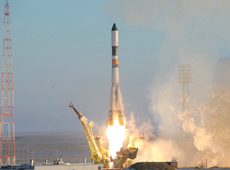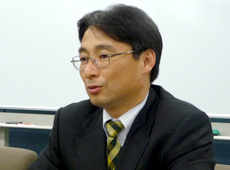TOP >
Special > Enhancing Quality of Life through Deep Understanding of Protein Structure


Q. Tell us about the international collaboration around protein crystal growth experiments in space?

Launch of Progress spacecraft, carrying samples for the protein crystal growth experiment (courtesy: S.P. Korolev RSC Energia)
Our protein crystal growth experiments are carried out in collaboration with Russia. The agreement is that JAXA is responsible for the experimental facilities on Kibo and for the overall operation, and offers one third of the experiment space to Russia. In return, Russia launches and retrieves our samples at no fee, using its Progress and Soyuz spacecraft.
From 2003 to 2008, prior to the completion of Kibo, JAXA used the Russian Service Module on the International Space Station (ISS) to conduct nine protein crystal growth experiments, and thanks to this experience we were able to accumulate various technologies for running experiments on the ISS.
Experiments on Kibo began in 2009, and two experiments have since been performed. The sample for the second experiment was launched on the Progress spacecraft last February, and after four months was safely returned to Earth with Japanese astronaut Soichi Noguchi on the Soyuz spacecraft.
Our collaboration with Russia on protein crystal growth experiments in space has been going really well. In fact, it will become more important in the future, as the Space Shuttle is being retired soon and opportunities for sample retrieval will be less frequent. Our collaboration with Russia began in 2003. Based on the relationship of trust we’ve built over time, I would like to continue to collaborate with Russia on experiments in other fields as well as protein crystal growth experiments.
Another partner in the protein crystal growth experiments on Kibo is the Malaysia National Space Agency. Prof. Raja Noor of Universiti Putra Malaysia launched protein collected in that country and has acquired experimental results.
JAXA promotes cooperation and collaboration with Asian countries through space applications. I expect that there will be further expansion of international collaboration with other nations in the region for the use of the ISS.

Q. How do you think the Japanese Experiment Module Kibo should be used in the future?

Japanese Experiment Module Kibo (courtesy: NASA)
We conducted protein crystal growth experiments in the Russian Service Module on the ISS for about five years before Kibo was completed, but it is definitely different to run experiments in the Japanese Experiment Module. It is indeed a great advantage to be able to freely carry out Japan’s own experiments. In my opinion, the significance of space development lies in participation, and Kibo is one of the tools we can use to bring Japanese science and technology to the rest of the world. Now, having a Japanese laboratory in space, I would like to make achievements to bring its benefits back to the people of Japan. At the same time, I think the Japanese Experiment Module Kibo should be used to make international contributions.
Q. What protein crystal growth experiments are scheduled now?

In the third experiment, scheduled for launch in the beginning of September, JAXA’s protein crystal growth experiments are focusing on applications. We are aiming to create proteins that will help solve social problems and develop cutting-edge technologies to meet social needs.
Our main pillar is the development of breakthrough medicines. In particular, we are targeting serious diseases with too few patients for the pharmaceutical industry to initiate R&D, and infectious diseases prevalent in developing nations. And for the second pillar, we will concentrate on the development of waste disposal, as well as enzymes involved in energy production, so that we can contribute to solving the Earth’s environmental problems and to the production of clean energy.
* Click here to learn more about protein crystal growth experiments
Masaru Sato
Associate Senior Engineer, Space Environment Utilization Center, Human Space Systems and Utilization Mission Directorate, JAXA
Mr. Sato graduated from Sendai National College of Technology in 1984, and joined the National Space Development Agency of Japan (now part of JAXA). He tracked and controlled satellites at the Masuda Tracking and Communication Station on Tanegashima Island, and at the Consolidated Space Tracking & Data Acquisition Department in Tsukuba. He has been engaged in planning for utilization and space experiments on the International Space Station since 1995. He was appointed to his current position in 2001.



